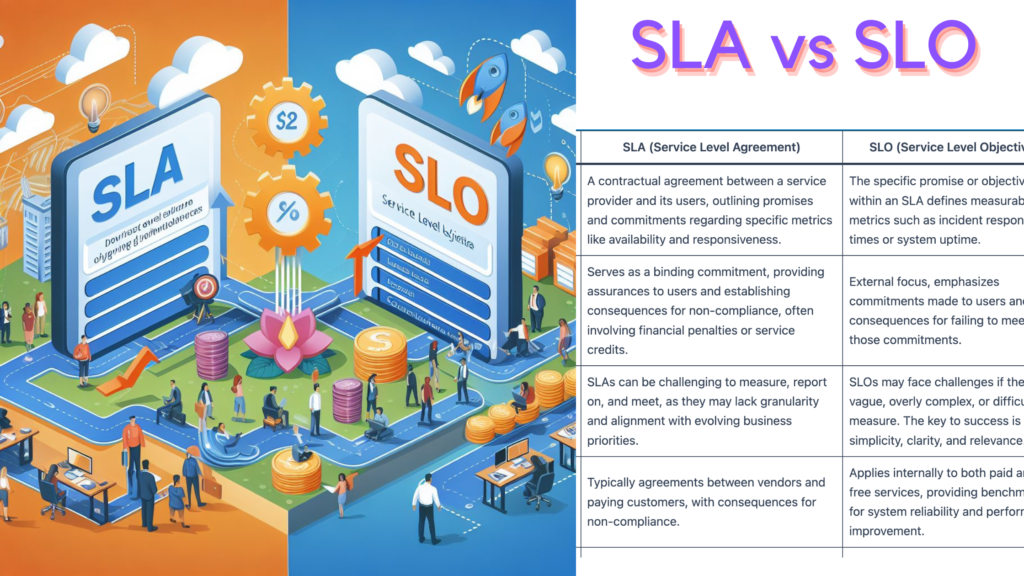What is Site Reliability Engineering (SRE)?
Site Reliability Engineering (SRE) is a software development discipline that combines software engineering and site reliability best practices in order to create scalable and highly reliable software systems. SRE teams are responsible for ensuring that a company’s software services meet or exceed their service level objectives (SLOs) by automating the majority of operational tasks, monitoring key metrics, and constantly improving the system’s design and architecture. In order to be successful, SRE teams must have a strong understanding of both software development and operations, as well as a shared commitment to automation and continual improvement.

Site Reliability Engineering (SRE) is a field of engineering that focuses on the availability, performance, and scalability of software systems. SRE is a practice that combines the disciplines of software engineering and operations to ensure that systems are designed for reliability and can meet the demands of users.
SRE is a relatively new field, and its practitioners are still working to define its scope and identify best practices. However, there are some common elements of SRE, including a focus on automation, monitoring, and self-healing systems.
The goal of SRE is to ensure that systems are available and performant. To achieve this, SRE teams focus on automation, monitoring, and self-healing systems.
Automation is key to SRE. By automating tasks, SRE teams can reduce the number of manual tasks that need to be performed. This not only saves time, but it also reduces the potential for human error.
Monitoring is another important element of SRE. By monitoring systems, SRE teams can identify issues before they cause outages. This allows SRE teams to prevent or mitigate problems before they impact users.
Finally, self-healing systems are an important part of SRE. By designing systems that can detect and recover from errors, SRE teams can minimize the impact of outages.
SRE is a young field, and there is still much to be learned about best practices. However, the focus on automation, monitoring, and self-healing systems is a good start. By following these practices, SRE teams can make sure that systems are available and performant.
SRE vs DevOps – how are they different?
DevOps is a set of practices that automates the operations tasks and accelerates software delivery. A DevOps team is a group of software engineers and operations experts who work together to improve the quality of software products.
Site reliability engineering (SRE) is a discipline that combines aspects of software engineering and operations. A site reliability engineer is responsible for the availability, performance, and efficiency of a company’s website or application. SRE teams use data from operations to improve the quality of their services.
SRE vs DevOps – any similarities?
There are many similarities between SRE and DevOps, as both emphasize collaboration between developers and operations teams, automation of tasks, and continuous improvement. Both disciplines also aim to improve the speed and quality of deployments, while reducing downtime and errors. However, there are some key differences between the two: SRE focuses more on availability and reliability of systems, while DevOps emphasizes continuous delivery and integration. DevOps also places a greater emphasis on culture and people, while SRE focuses more on processes and tools.
How does DevOps Work?
DevOps is a set of practices that helps organizations to better understand how their development and operations teams work together to deploy software. By automating the software development process, DevOps teams can make sure that code changes are made in a consistent and repeatable way. They can also use metrics to monitor the success of their deployments, and identify areas where the process can be improved.
Can a Site Reliability Engineering Team Prevent Production Incidents?
Yes, a site reliability engineering (SRE) team can prevent production incidents. SRE is a field of computer science that combines software engineering and operations to build, operate, and maintain systems at scale. SRE teams use various tools and techniques to prevent production incidents, such as monitoring system uptime and performance, automating tasks, and managing capacity.
When do companies need DevOps and SRE?
There is no one-size-fits-all answer to this question, as the need for DevOps and SRE will vary from company to company depending on a number of factors. However, in general, companies will need DevOps and SRE when they are looking to automate operations tasks, improve site reliability, and/or speed up the delivery of new features or updates (ci/cd). A devops engineer or sre team can help with these goals.
Okay, Then What’s DevOps?
DevOps is a term for a set of practices that emphasize the collaboration and communication of both software developers and other information-technology (IT) professionals while automating the process of software delivery and infrastructure changes. It aims to help an organization rapidly produce software products and services.
The term “DevOps” was first coined by a group of IT professionals in 2009. The group was seeking to find a new way to describe the then-emerging practice of integrating development (Dev) and operations (Ops).
Since then, the DevOps movement has gained popularity and momentum. Many organizations have adopted DevOps practices, and there is now a growing number of DevOps tools available.
There are many different roles within a DevOps team, but some common ones include:
• Developer: A software developer is responsible for coding, testing, and debugging applications.
• Operations: Operations staff are responsible for managing, monitoring, and maintaining systems and networks. They may also be involved in incident response and problem solving.
• Site reliability engineer (SRE): SREs are responsible for ensuring that systems are reliable and available. They may also be involved in capacity planning, performance tuning, and incident response.
What is the role of a Site Reliability Engineer?
A site reliability engineer (SRE) is a software engineering role that combines aspects of software development with operations. The main goal of an SRE is to create and maintain a reliable, scalable, and self-healing software system. SREs are responsible for the availability, performance, and security of a company’s website or application. They work closely with developers and operations teams to automate tasks, manage changes, and ensure that service level agreements (SLAs) are met.
What Are the Similarities and Differences Between DevOps and SRE?
There are a few key similarities and differences between DevOps and SRE. Both aim to bridge the gap between development and operations, and both are used to be called “operations”. However, DevOps is more focused on the development team, while SRE is more focused on the software engineer. Additionally, DevOps happens when a software engineer works with the operations team, while SRE happens when the operations team works with the development team.
What Are the Benefits and Drawbacks of DevOps?
DevOps is a term for the relationship between development and operations. It is a set of practices that automates the processes between software development and IT operations. DevOps brings together people, processes, and technology to increase the speed and quality of software delivery. The main benefits of DevOps are faster delivery of features, higher quality of code, and increased collaboration between development and operations teams. However, there are also some drawbacks to DevOps, such as the need for specialized skills and the potential for increased complexity.
Does Your Company Need DevOps, SRE, or Both?
There is no one-size-fits-all answer to this question, as the needs of each company vary. However, in general, DevOps and SRE can both be beneficial to organizations. DevOps can help to speed up the software development process, while SRE can help to improve the reliability and stability of systems. In many cases, both DevOps and SRE may be needed in order to achieve optimal results.
What is the Effect of SRE Initiatives on DevOps?
There is no one-size-fits-all answer to this question, as the effect of SRE initiatives on DevOps will vary depending on the specific organization and context. However, in general, SRE initiatives can help to improve the efficiency and quality of software development by automating repetitive tasks, breaking down silos between teams, and improving communication and collaboration between developers and operations staff. Additionally, SRE can help to improve service levels by providing better visibility into metrics and SLAs, and by automating the process of detecting and responding to incidents. Ultimately, by integrating SRE into the overall DevOps process, organizations can improve the speed, quality, and reliability of their software development efforts.
SRE initiatives are all about improving the quality of service for customers. But what does that mean for the development process? In this blog post, we’ll explore the effect of SRE initiatives on DevOps.
The first thing to understand is that SRE is not a new concept. It’s been around for years, but it’s only recently that it’s become a more formalized discipline. SRE stands for Site Reliability Engineering, and it’s a set of practices and principles that focus on ensuring that services are reliable and available.
One of the main goals of SRE is to reduce toil. Toil is any work that is repetitive, manual, and doesn’t add value. It’s the type of work that can be automated, and that’s one of the things that SRE is all about. Automating toilous work can free up time for more important work, like improving the customer experience.
SRE is also about blamelessness. When something goes wrong, it’s important to be able to identify what went wrong and why, without placing blame on anyone. This type of thinking leads to a more positive and productive work environment, and it’s something that’s essential for DevOps.
So, what does all of this mean for DevOps? DevOps is all about collaboration between development and operations. And SRE is all about improving quality of service. So, it stands to reason that SRE initiatives can have a positive effect on DevOps.
One of the benefits of SRE is that it can help to improve the quality of service. When SRE initiatives are in place, there’s less toil, and that means that there’s more time to focus on improving the customer experience. And, because SRE is all about blamelessness, it can help to create a more positive and productive work environment. All of these things can have a positive impact on DevOps.
SRE initiatives can also help to improve the efficiency of the development process. When toil is reduced, it’s easier to identify and fix problems. And, because SRE is all about automation, it can help to automate tasks that are repetitive and manual. All of these things can help to improve the efficiency of the development process.
In conclusion, SRE initiatives can have a positive effect on DevOps. They can help to improve the quality of service, and they can help to improve the efficiency of the development process.
How can SREs support DevOps?
SREs can support DevOps in many ways, but perhaps the most important is by helping to automate tasks and processes. By automating repetitive or time-consuming tasks, SREs can free up time for developers to focus on more important work. Additionally, SREs can help to streamline communication and collaboration between DevOps and SRE teams. By working together, these teams can more effectively identify and solve problems, and improve the overall efficiency of the organization.
The role of SREs is to support the development and operation of services. They are responsible for ensuring that services are available and responsive to user requests. SREs work closely with developers to ensure that new features are deployed in a reliable and scalable manner. They also work with operation teams to ensure that services are properly monitored and maintained.
One of the challenges faced by SREs is that they must balance the need for availability and responsiveness with the need for stability and predictability. To meet this challenge, SREs have developed a number of practices and tools.
Availability:
SREs strive to keep services available and responsive to user requests. To achieve this, they often use techniques such as redundancy and self-healing systems.
Redundancy:
Redundancy is a technique used to improve the availability of a system. In a redundant system, if one component fails, the others can continue to operate. This allows the system to continue to provide its services even in the event of a failure.
Self-healing systems:
Self-healing systems are designed to automatically detect and correct errors. This can help to improve the availability of a system by reducing the need for manual intervention.
Stability:
SREs also strive to keep services stable and predictable. To achieve this, they often use techniques such as release management and capacity planning.
Release management:
Release management is the process of planning, testing, and deploying new versions of a service. This helps to ensure that new versions of a service are deployed in a controlled and safe manner.
Capacity planning:
Capacity planning is the process of determining the future needs of a service. This helps to ensure that a service can continue to meet the demands of its users.
The role of SREs is to support the development and operation of services. SREs work closely with developers to ensure that new features are deployed in a reliable and scalable manner. They also work with operation teams to ensure that services are properly monitored and maintained.
SREs strive to keep services available and responsive to user requests. To achieve this, they often use techniques such as redundancy and self-healing systems. They also strive to keep services stable and predictable. To achieve this, they often use techniques such as release management and capacity planning.
DevOps practices & methods
DevOps is a set of practices that aim to automate and improve the software development and deployment process. DevOps practices include continuous integration (CI) and continuous delivery (CD), which are designed to help software engineers work more efficiently and effectively. DevOps also uses automation to help manage the software development lifecycle, from development to deployment. By automating the software development process, DevOps can help improve the quality of software products and shorten the time it takes to get new features or updates into the hands of users.
DevOps & SRE Tools
For DevOps, one of the most popular tools is Puppet. Puppet is a configuration management tool that helps manage and automate server deployments. It’s been around for a while and is used by many large companies, so it’s well-tested and supported.
Another popular tool for DevOps is Ansible. Ansible is similar to Puppet in that it helps with configuration management and server deployments. However, it’s newer than Puppet and so it has a few more modern features. One of these is its support for container orchestration, which is becoming increasingly important as more and more companies adopt containers.
For SRE, one of the most popular tools is Prometheus. Prometheus is a monitoring tool that helps track the performance of systems and services. It’s open source and has a large community of users and developers, so it’s well-supported.
Another popular SRE tool is Grafana. Grafana is a data visualization tool that can be used to create dashboards of metrics. This is useful for monitoring the performance of systems and services, and for quickly identifying issues.
These are just a few of the many tools available for DevOps and SRE. In our next blog post, we’ll take a look at some of the other popular tools.

